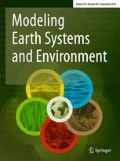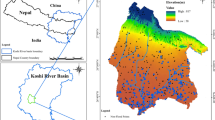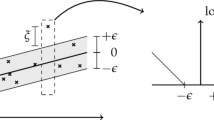Abstract
In this paper, recharging rate of stormwater filter system is assessed by using predictive models of Gaussian Process (GP) and Support Vector Machines (SVM). Four kernel functions: normalized poly kernel, polynomial kernel, Pearson VII kernel (PUK) and radial basis kernel (RBF) were used with both modelling approaches (GP and SVM). A dataset consists of 678 measurements was collected from the experimental investigations on the infiltration of the storm-water filter system. Out of 678 observations, randomly selected 462 observations were used for training, whereas remaining 216 were used for testing the model. Input variables were comprise of cumulative time (T), the thickness of medium sand bed (B), size of medium sand (S) and concentration of impurities (Conc.), whereas the recharging rate (R) was considered as output. Correlation coefficient (C.C) and root mean square error (RMSE) were used to compare the performance of both modelling approaches. The evaluation of result suggests that Pearson VII based GP regression approach works well as compared to the other kernel functions based on GP and SVM models. Sensitivity analysis suggested that the size of medium sand (S) is an important parameter for predicting the recharging rate of stormwater filter system. Parametric study outcomes suggested that the higher size of medium sand increases the recharging rate, and a higher concentration of impurities in water decreases the recharging rate. Moreover, on expanding the thickness of the medium sand bed the recharging rate of the storm water filter system was observed to be increased.











Similar content being viewed by others
References
Boser BE, Guyon IM, Vapnik VN (1992) A training algorithm for optimal margin classifiers. In: Proceedings of the fifth annual workshop on Computational learning theory. ACM, pp 144–152
Farooq S, Al-Yousef AK (1993) Slow sand filtration of secondary effluent. J Environ Eng 119(4):615–630
Huang S, Chang J, Huang Q, Chen Y (2014) Monthly streamflow prediction using modified EMD-based support vector machine. J Hydrol 511:764–775
Kaledhonkar MJ, Singh OP, Ambast SK, Tyagi NK, Tyagi KC (2003) Artificial groundwater recharge through recharge tubewells: a case study. J Inst Eng (India)-AG 84:28–32
Kambale JB, Sarangi A, Singh DK, Singh AK (2009) Performance evaluation of filtration unit of groundwater recharge shaft: laboratory study. Curr Sci 471–474
Kisi O, Cimen M (2011) A wavelet-support vector machine conjunction model for monthly streamflow forecasting. J Hydrol 399(1):132–140
Kumar S, Kamra SK, Yadav RK, Sharma JP (2012) Evaluation of sand-based stormwater filtration system for groundwater recharge wells. Curr Sci 395–404
Kumar M, Ranjan S, Tiwari NK, Gupta R (2017) Plunging hollow jet aerators-oxygen transfer and modelling. ISH J Hydraul Eng 1–7
Kuss M (2006) Gaussian process models for robust regression, classification, and reinforcement learning (Doctoral dissertation, Technische Universität)
Le Coustumer S, Barraud S (2007) Long-term hydraulic and pollution retention performance of infiltration systems. Water Sci Technol 55(4):235–243
Mohanty S, Jha MK, Kumar A, Panda DK (2013) Comparative evaluation of numerical model and artificial neural network for simulating groundwater flow in Kathajodi–Surua Inter-basin of Odisha, India. J Hydrol 495:38–51
Rasmussen CE, Williams CK (2006) Gaussian processes for machine learning, vol 1. MIT press, Cambridge
Sadiq R, Al-Zahrani MA, Sheikh AK, Husain T, Farooq S (2004) Performance evaluation of slow sand filters using fuzzy rule-based modelling. Environ Model Softw 19(5):507–515
Sihag P, Tiwari NK, Ranjan S (2017a) Modelling of infiltration of sandy soil using gaussian process regression. Modeling Earth Syst Environ 3(3):1091–1100
Sihag P, Tiwari NK, Ranjan S (2017b) Prediction of unsaturated hydraulic conductivity using adaptive neuro-fuzzy inference system (ANFIS). ISH J Hydraul Eng 1–11
Singh KK, Jain P (2015) Performance evaluation of filtration system for groundwater recharging well in the presence of medium sand-mixed storm water. Int J Civ Environ Eng 9(3):252–255
Singh B, Sihag P, Singh K (2017) Modelling of impact of water quality on infiltration rate of soil by random forest regression. Model Earth Syst Environ 3(3):999–1004
Siriwardene NR, Deletic A, Fletcher TD (2007) Clogging of stormwater gravel infiltration systems and filters: insights from a laboratory study. Water Res 41(7):1433–1440
Thomas RL (1968) Coarse filter media for artificial recharge. Illinois State Water Survey, Urbana Report of Investigation 60
Tiwari NK, Sihag P, Ranjan S (2017) Modeling of infiltration of soil using adaptive neuro-fuzzy inference system (ANFIS). J Eng Technol Educ 11(1):13–21
Vapnik VN, Vapnik V (1998) Statistical learning theory, vol 1. Wiley, New York
Xing B, Gan R, Liu G, Liu Z, Zhang J, Ren Y (2015) Monthly mean streamflow prediction based on bat algorithm-support vector machine. J Hydrol Eng 21(2):04015057
Author information
Authors and Affiliations
Corresponding author
Rights and permissions
About this article
Cite this article
Sihag, P., Jain, P. & Kumar, M. Modelling of impact of water quality on recharging rate of storm water filter system using various kernel function based regression. Model. Earth Syst. Environ. 4, 61–68 (2018). https://doi.org/10.1007/s40808-017-0410-0
Received:
Accepted:
Published:
Issue Date:
DOI: https://doi.org/10.1007/s40808-017-0410-0




